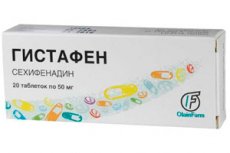组胺
阿列克謝·克雷文科,医学审稿人
最近審查:04.07.2025
最近審查:04.07.2025

Histafen(司倍非那定)是一种用于治疗过敏反应的抗组胺药。司倍非那定作为H1组胺受体阻滞剂,有助于减轻体内组胺释放引起的症状,例如瘙痒、流鼻涕和眼刺激。
一项关于 Histafen 在老年性瘙痒症患者中使用的研究表明,该药物显著改善了大多数患者的病情,减轻了瘙痒症状,提高了生活质量(Dyudyun & Polion,2019)。
对于需要组胺受体阻断来减轻或预防过敏症状的患者,Histafen 可能是治疗过敏反应的有效选择。
適應症 希塔芬
- 过敏性鼻炎(花粉热):Histafen 可以帮助缓解因对花粉、灰尘、动物皮屑和其他过敏原的反应引起的鼻塞、流鼻涕、打喷嚏和鼻子发痒。
- 季节性过敏性鼻炎(花粉症):这种药物可用于治疗由季节性过敏原(如草和树花粉)引起的过敏反应引起的症状。
- 过敏性结膜炎:Histafen 可以帮助减轻由过敏性结膜炎(例如接触灰尘、花粉或动物)引起的眼睛发痒、发红和流泪。
- 荨麻疹(风疹):这种药物可能有效缓解与荨麻疹或其他过敏性皮肤反应相关的皮肤瘙痒、发红和肿胀。
- 其他过敏情况:Histafen 还可用于治疗其他过敏情况,包括对昆虫叮咬的过敏反应、过敏性皮炎和对食物的过敏反应,前提是该药物是由医生开的。
發布表單
Histafen 通常以口服片剂形式提供。
藥效學
作用机制:
- 西替非那定是一种阻断外周 H1 组胺受体的抗组胺药。
- 组胺是人体因过敏反应而释放的一种物质。组胺会引起瘙痒、流鼻涕、眼睛发红等过敏症状。
- 用西替非那定阻断H1组胺受体可阻止组胺的作用,从而导致过敏症状减轻或消失。
藥代動力學
- 吸收:口服后,二苯胺一般在胃肠道良好吸收,血药浓度通常在服药后2-4小时达到峰值。
- 代谢:西芬那定的主要代谢途径是在肝脏中经细胞色素P450 3A4氧化。主要代谢物是地氯雷他定和3-羟基地氯雷他定。地氯雷他定也具有抗组胺作用,可单独用于治疗过敏症。
- 排泄:西芬那定代谢物及西芬那定本身主要经尿液和粪便排泄。在肾小球滤过系数(GFC)正常的健康成人中,西芬那定的药代动力学未发生改变,但在肾功能不全(尤其是重度肾功能不全)的患者中,消除可能会延迟。
- 半衰期:塞西芬那定在体内的半衰期约为 14 小时,因此可以每天服用一次或两次,具体取决于医生的建议和药物的形式。
- 食物影响:食物摄入,尤其是油腻食物,可能会延迟西西哌那定的吸收,但不会显著影响其整体生物利用度。
- 药物相互作用:Secyphenadine 可能与其他药物相互作用,包括通过细胞色素 P450 3A4 系统代谢的药物,例如大环内酯类抗生素、蛋白酶抑制剂等。
劑量和管理
使用方法:
- Histafen 通常采用口服方式服用。
- 通常用少量水将药片整片吞服。
- 无论是否进食都可以服用该药物。
剂量:
- Histafen 的剂量可能根据患者的年龄、体重和过敏症状的严重程度而有所不同。
- 对于成人和 12 岁以上儿童,通常建议剂量为每天服用一次 60 毫克。
- 对于 6 至 12 岁的儿童,通常建议剂量为 30 毫克,每天服用一次。
- 对于 2 至 6 岁的儿童,通常建议剂量为每天服用一次 15 毫克。
- 对于 2 岁以下的儿童,建议在使用 Histafen 前咨询医生。
入院时长:
- 服用 Histafen 的持续时间通常由医生根据过敏症状的性质和严重程度决定。
- 通常在患者接触过敏原的整个期间服用该药物,但治疗持续时间应由医生决定。
在懷孕期間使用 希塔芬
由于缺乏关于司倍非那定(Histafen)对发育中胎儿安全性的数据,不建议在妊娠期间使用。关于司倍非那定对妊娠和胎儿发育的影响,科学文献中仍存在疑问。
虽然对倍半非那定的直接研究有限,但对其他抗组胺药(例如特非那定(倍半非那定的结构类似物))的研究表明,孕期使用不会增加重大出生缺陷的风险。然而,研究发现,暴露于特非那定的婴儿平均出生体重略低于对照组(Loebstein 等人,1999 年)。
根据这些数据,建议避免在怀孕期间使用司奎非那定,尤其是在未咨询医生的情况下,医生可以根据个人临床情况评估使用司奎非那定的潜在风险和益处。
禁忌
- 过敏症:已知对司奎非那定或该药物的任何其他成分过敏的人不应服用 Histafen。
- CYP3A4 酶抑制剂的使用:将司奎非那定与 CYP3A4 酶抑制剂(如酮康唑或红霉素)联合使用可能会增加司奎非那定的血液浓度,并增加心血管副作用的风险。
- 增加心血管并发症的风险:司奎非那定可能会增加心血管并发症的风险,尤其是对于患有心脏病、心律失常或服用其他可能影响心律的药物的人。
- 怀孕和哺乳:关于在怀孕和哺乳期间使用司奎非那定的安全性的信息有限,因此在此期间使用时应遵照医生的处方。
- 儿科用途:未经医生许可,不建议 6 岁以下儿童使用司奎非那定。
- 肝功能损害:严重肝功能损害的患者应避免使用司奎非那定或在医生监督下谨慎使用。
- 酒精摄入:服用司奎非那定期间饮酒可能会增加其一些副作用,例如嗜睡和中枢神经系统抑制。
副作用 希塔芬
- 嗜睡或疲倦:部分患者服用 Histafen 后可能会感到嗜睡或疲倦。同时服用酒精或其他镇静剂可能会加重这种副作用。
- 头晕:部分患者服药后可能会出现头晕或站立不稳的症状。
- 口干:有些人服用 Histafen 后可能会出现口干。
- 胃部不适:可能会出现恶心、呕吐、腹泻或便秘等胃部不适。
- 失眠或焦虑:对于某些人来说,使用 Histafen 可能会导致失眠或焦虑。
- 罕见的副作用:在极少数情况下,可能会出现更严重的副作用,例如过敏反应、肌肉疼痛、虚弱或记忆问题。
過量
希斯塔芬过量服用的症状可能包括:
- 困倦或疲劳。
- 头晕或站立不稳。
- 口干。
- 腹痛或胃部不适。
- 罕见的是,可能会出现更严重的症状,如心跳加快、呼吸困难,甚至癫痫发作。
與其他藥物的相互作用
- 经细胞色素 P450 3A4 代谢的药物:塞西非那定在肝脏中经细胞色素 P450 3A4 酶代谢。该酶的抑制剂或诱导剂可能会影响塞西非那定的代谢。例如,酮康唑、红霉素或利托那韦等细胞色素 P450 3A4 抑制剂可能会增加塞西非那定的血药浓度,从而可能增强疗效并增加不良反应的风险。
- 酒精:服用塞西非那定的同时饮酒可能会增强其镇静作用,导致困倦和嗜睡加剧。
- 其他中枢作用药物:塞西非那定可能会增强其他中枢作用药物(例如催眠药、抗焦虑药和抗抑郁药)的镇静作用。这可能会增加嗜睡和倦怠等不良反应的风险。
- 抗组胺药:将塞西非那定与其他抗组胺药一起使用可能会增加其效力,但也可能增加副作用的风险。
- 增加胃肠道 pH 值的药物:抗酸剂或胃灼热药物等药物可能会影响西非那定从胃肠道吸收的速度和程度,从而降低其有效性。
注意!
為了簡化對信息的理解,本指令使用了藥物 "组胺",並根據藥物的醫療用途官方說明。 使用前請閱讀直接用於藥物的註釋。
描述僅供參考,不適用於自我修復指導。 這種藥物的需求,治療方案的目的,藥物的方法和劑量僅由主治醫師確定。 自我藥療對你的健康有危害。


